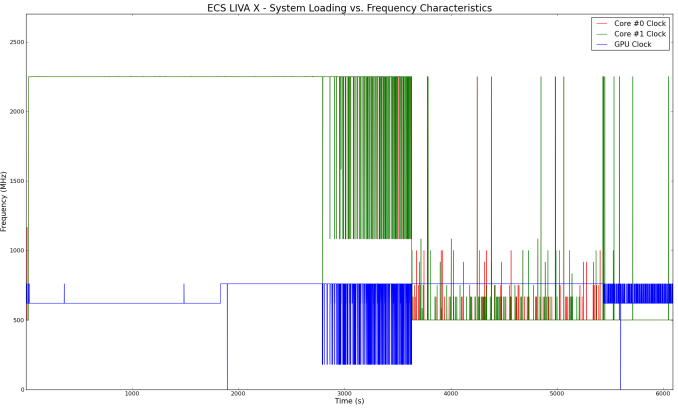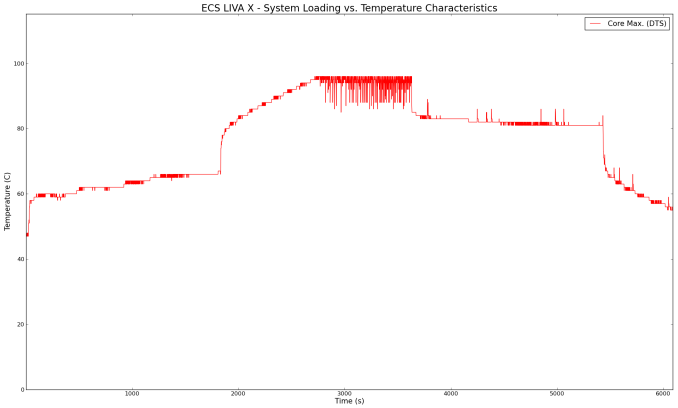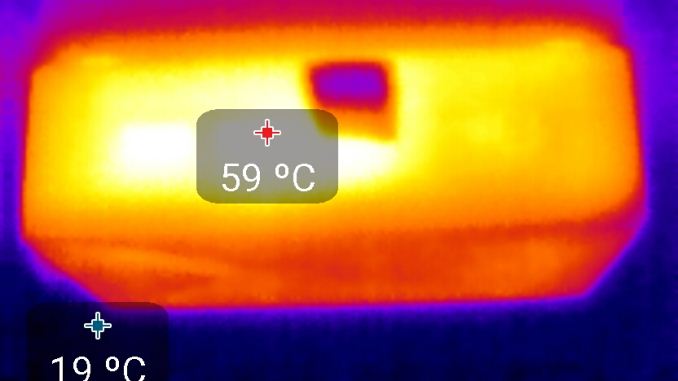ECS LIVA X Review: A Fanless Bay Trail-M mini-PC
by Ganesh T S on January 16, 2015 11:30 AM ESTPower Consumption and Thermal Performance
The power consumption at the wall was measured with a 1080p display being driven through the HDMI port. In the graphs below, we compare the idle and load power of the ECS LIVA X with other passively cooled PCs evaluated before. For load power consumption, we ran Furmark 1.12.0 and Prime95 v27.9 together. The numbers are not beyond the realm of reason for the combination of hardware components in the machine.


Load power consumptionis slightly higher in the LIVA X, but that is to be expected with the bump in the clock speeds compared to the original LIVA. The LIVA and the LIVA X turn out to be amongst the most power efficient passively cooled PCs that we have evaluated
In order to evaluate thermal performance, we first ran our test for load power consumption and made sure that the unit wasn't getting throttled. In order to determine the efficiency of the cooling system, we first loaded up the CPU alone using just Prime 95 for around 30 minutes. This was followed by addition of the GPU load (FurMark) for another 30 minutes, and then removal of the CPU load for 10 minutes. The system was then left idle. The various clocks in the system as well as the temperatures within the unit are presented below.
One thing to note is that the cores are configured to run at the turbo speed (2.25 GHz) when the system is stressed. Unfortunately, half-way through our CPU + GPU load test, the system started throttling, with the CPU clocks going as low as 1.1 GHz (from 2.25 GHz) and the GPU clocks going as low as 200 MHz (from the 760 MHz loaded state). The drops in the frequency can be directly correlated with the core temperature graphed below at the same time. Even though the CPU doesn't reach the maximum junction temperature of 100 C, ECS has opted for precautionary throttling at 96 C itself.
The throttling was very surprising because ECS has opted for a very thick thermal heat sink (evident in the increased weight of the system) which should potentially perform much better compared to what was in the ECS LIVA. It turned out that the media samples we received had the thermal pads in the wrong place. Customer shipments will shift them a bit to resolve the overheating issue.
Another important aspect to keep note of while evaluating fanless PCs is the chassis temperature. Using Seek Thermal's thermal imager, we observed the chassis temperature after the CPU package temperature reached the steady state value (and immediately after thermal throttling started) in the above graph.
Even though the internal core temperature was close to 100 C, the chassis itself never got too hot to touch. As our thermal imager showed, the maximum external temperature was only 59 C.













35 Comments
View All Comments
ozzuneoj86 - Saturday, January 17, 2015 - link
Seems a bit expensive for its capabilities. A 1.58Ghz Bay Trail is pretty slow for a non-mobile device.ganeshts - Saturday, January 17, 2015 - link
They run the CPU at 2.25 GHz (max. turbo speed) throughout the time the CPU is loaded. At this point of time, CPUs with such clocks are more than enough for thin-clients and basic browsing / word-processing [ well, that is what the market reception to the original ECS LIVA signified to ECS :) ]In the end, it is all a matter of 'horses for courses' - what fits the requirements of one person might be an overkill for someone else (isn't that why tablet PC sales have caused a decline in shipment of low-end notebooks / PCs?)
ozzuneoj86 - Saturday, January 17, 2015 - link
I see, I missed that about it running at its max turbo since it isn't limited thermally.I guess I just have trouble picturing the target market being anyone who actually knows what they are getting vs. what they need. Most of the places that I've seen thin clients used could easily just use a small ITX-sized desktop PC that is significantly faster, and (as is the case with this LIVA X) you generally pay a price premium for a thin client sized system. When you factor in the OS price, it seems unlikely that cost has anything to do with the purchase of a system like this, so that leaves size as the only real reason to get one.
My workplace replaced several Core 2 based itx-sized HP desktops a few years ago with these awful little WYSE thin clients. Everything takes longer, runs slower and now there is a tiny bit more desktop space for people to clutter paperwork that shoudn't be left out in the first place. I'm sure there will be some power savings, but it can't be much in relation to the cost of installing a bunch of new equipment, and they are already at their limit as far as capabilities. I give it another year before we have some new application that is too much for them to handle.
Obviously this LIVA system is faster, but it just doesn't seem like that many places are so constrained for space that PCs of this size are actually necessary, and for those that are, there are cheaper and faster alternatives, even at this price point (mostly due to the OS not being included).
kgh00007 - Saturday, January 17, 2015 - link
They need to sell a Windows 8.1 with Bing edition of these, the windows Licence increases the cost of the device by 1.5 times!!That's the biggest barrier to these cheaper mini PC's for me and for recommending them to anyone like family members!
Teknobug - Saturday, January 17, 2015 - link
hmm only dual core? I've been liking those Bay Trail Z37**'s.powerarmour - Saturday, January 17, 2015 - link
If a 59'C case temp isn't hot to touch, you probably need to visit the doctor!, 100'C core temps are ridiculous also, terrible design.ganeshts - Saturday, January 17, 2015 - link
The Zotac C-series with the Core i5-Y CPUs had chassis temperatures of the order of 75C. This is definitely much better.As for the 96 C core temp prior to throttling, there was a thermal pad placement issue in the media review samples. Seeing how this is similar to LIVA in terms of CPU performance and the fact that the material used for thermal protection is far superior, I have no doubt the units reaching the end user will have much lower core temperatures under *power virus* loads.
kmmatney - Sunday, January 18, 2015 - link
The temp is running furmark and Prime95 at the same time, which is a way higher load than normal. I've had computers that would crash while running that test, but were otherwise rock stable no matter what else I did.Oxford Guy - Monday, January 19, 2015 - link
Exactly. Who is ever going to use one of these for anything like that sort of load. It's bogus.BrokenCrayons - Tuesday, January 20, 2015 - link
I think the point of including an unrealistic scenario like furmark + prime95 is to stress the system in a way that induces a worst possible case situation. While most end users won't ever have that sort of thermal load on their hardware, doing this kind of testing in a review exposes potential flaws that wouldn't otherwise be discovered. I'd much rather someone does that kinda thing for me and uncovers a problem than having to figure it out for myself after I've made a purchase and have put it to use.